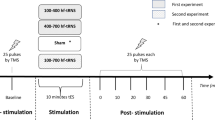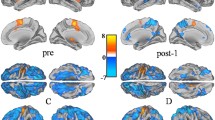Abstract
Manipulation of cortical excitability can be experimentally achieved by the application of transcranial random noise stimulation (tRNS). TRNS is a novel method of non-invasive electrical brain stimulation whereby a random electrical oscillation spectrum is applied over the cortex. A previous study recently reported that application of weak 10-min tRNS over primary motor cortex (M1) enhances corticospinal excitability both during and after stimulation in the healthy human brain. Here, blood oxygenation level dependent (BOLD) MRI was used to monitor modulations in human sensorimotor activity after the application of 4-min tRNS. Activation maps for a right hand index–thumb finger opposition task were obtained for nine subjects after sham and 1-mA tRNS in separate sessions. TRNS of the left-hemispheric sensorimotor cortex resulted in a decrease in the mean number of activated pixels by 17%, in the hand area. Our results indicate that tRNS applied with different durations and/or in combination with a task might result in different outcomes. Application of tRNS to the human cortex allows an unnoticeable and thus painless, selective, non-invasive and reversible activity change within the cortex, its main advantage being the direction insensitivity of the stimulation. TRNS also provides a qualitatively new way of producing and interfering with brain plasticity, although, further research is required to optimise stimulation parameters and efficacy.



Similar content being viewed by others
References
Antal A, Begemeier S, Nitsche MA, Paulus W (2008) Prior state of cortical activity influences subsequent practicing of a visuomotor coordination task. Neuropsychologia 46(13):3157–3161
Baudewig J, Nitsche MA, Paulus W, Frahm J (2001) Regional modulation of BOLD MRI responses to human sensorimotor activation by transcranial direct current stimulation. Magn Reson Med 45(2):196–201
Benabid AL, Wallace B, Mitrofanis J, Xia R, Piallat B, Chabardes S, Berger F (2005) A putative generalized model of the effects and mechanism of action of high frequency electrical stimulation of the central nervous system. Acta Neurol Belg 105(3):149–157
Bienenstock EL, Cooper LN, Munro PW (1982) Theory for the development of neuron selectivity: orientation specificity and binocular interaction in visual cortex. J Neurosci 2(1):32–48
Bikson M, Hahn PJ, Fox JE, Jefferys JG (2003) Depolarization block of neurons during maintenance of electrographic seizures. J Neurophysiol 90(4):2402–2408
Bromm B (1968) Die Natrium-Gleichrichtung der unterschwellig erregten Membran in der quantitative Formulierung der Ionentheorie. Pflügers Arch 302:233–244
Fregni F, Pascual-Leone A (2007) Technology insight: noninvasive brain stimulation in neurology-perspectives on the therapeutic potential of rTMS and tDCS. Nat Clin Pract Neurol 3(7):383–393
Grenier F, Timofeev I, Steriade M (2001) Focal synchronization of ripples (80–200 Hz) in neocortex and their neuronal correlates. J Neurophysiol 86:1884–1898
Kwon YH, Ko MH, Ahn SH, Kim YH, Song JC, Lee CH, Chang MC, Jang SH (2008) Primary motor cortex activation by transcranial direct current stimulation in the human brain. Neurosci Lett 435(1):56–59
Logothetis NK, Pauls J, Augath M, Trinath T, Oeltermann A (2001) Neurophysiological investigation of the basis of the fMRI signal. Nature 412(6843):150–157
Lozano AM, Eltahawy H (2004) How does DBS work? Suppl Clin Neurophysiol 57:733–736
Maeda F, Keenan JP, Tormos JM, Topka H, Pascual-Leone A (2000) Interindividual variability of the modulatory effects of repetitive transcranial magnetic stimulation on cortical excitability. Exp Brain Res 133(4):425–430
Matsuoka AJ, Abbas PJ, Rubinstein JT, Miller CA (2000) The neuronal response to electrical constant-amplitude pulse train stimulation: additive Gaussian noise. Hear Res 149(1–2):129–137
Nitsche MA, Paulus W (2000) Excitability changes induced in the human motor cortex by weak transcranial direct current stimulation. J Physiol 527:633–639
Nitsche MA, Paulus W (2001) Sustained excitability elevations induced by transcranial DC motor cortex stimulation in humans. Neurology 57:1899–1901
Nitsche MA, Liebetanz D, Lang N, Antal A, Tergau F, Paulus W (2003) Safety criteria for transcranial direct current stimulation (tDCS) in humans. Clin Neurophysiol 114(11):2220–2222
Oldfield RC (1971) The assessment and analysis of handedness: the Edinburgh inventory. Neuropsychologia 9:97–113
Schoen I, Fromherz P (2008) Extracellular stimulation of mammalian neurons through repetitive activation of Na+ channels by weak capacitive currents on a silicon chip. J Neurophysiol 100:346–357
Sejnowski TJ (1977) Statistical constraints on synaptic plasticity. J Theor Biol 69(2):385–389
Terney D, Chaieb L, Moliadze V, Antal A, Paulus W (2008) Increasing human brain excitability by transcranial high-frequency random noise stimulation. J Neurosci 28(52):14147–14155
Viswanathan A, Freeman RD (2007) Neurometabolic coupling in cerebral cortex reflects synaptic more than spiking activity. Nat Neurosci 10(10):1308–1312
Ward LM, Doesburg SM, Kitajo K, MacLean SE, Roggeveen AB (2006) Neural synchrony in stochastic resonance, attention, and consciousness. Can J Exp Psychol 60(4):319–326
Wiesenfeld K, Moss F (1995) Stochastic resonance and the benefits of noise: from ice ages to crayfish and SQUIDs. Nature 373(6509):33–36
Yamamoto Y, Struzik ZR, Soma R, Ohashi K, Kwak S (2005) Noisy vestibular stimulation improves autonomic and motor responsiveness in central neuro-degenerative disorders. Ann Neurol 58:175–181
Acknowledgements
We acknowledge our financial support given by the German Ministry for Education and Science (BMBF) via the Bernstein Centre for Computational Neuroscience (BCCN), Goettingen (Grant No. 01GQ0432).
Author information
Authors and Affiliations
Corresponding author
Rights and permissions
About this article
Cite this article
Chaieb, L., Kovacs, G., Cziraki, C. et al. Short-duration transcranial random noise stimulation induces blood oxygenation level dependent response attenuation in the human motor cortex. Exp Brain Res 198, 439–444 (2009). https://doi.org/10.1007/s00221-009-1938-7
Received:
Accepted:
Published:
Issue Date:
DOI: https://doi.org/10.1007/s00221-009-1938-7




